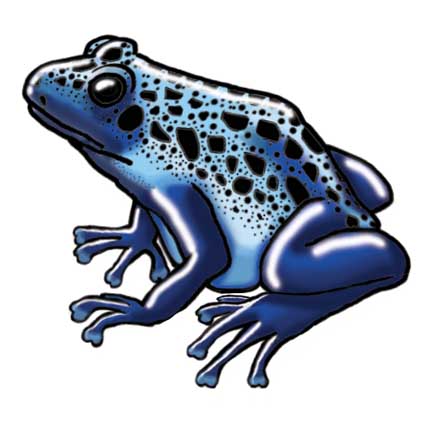

They are found in South America in Suriname and Brazil.
They live in tropical rainforests near water.
They are bright blue, with darker blue legs and chest and black speckles. They can reach 1.75 inches (4.5 cm) long and weigh about 1/4 ounce. They have toxins in their skin that protects them from predators. They have four toes on their front feet and five on the back with suction-cup-like tips for gripping. Females are slightly larger with rounder toe tips. Males have heart-shaped toe tips. They have a hunch-backed bady shape.
They active during the day (diurnal). They are territorial using calls to warn away trespassers. They will "wrestle" intruders.
They eat small insects and spiders.
They breed during the rainy season in late winter. The female will lay her eggs near the water in her mate's territory – which he will defend. They hatch after about two weeks and take 2.5-3 months to mature.
They live up to 10 years in captivity (they are very popular pets in the U.S.) and less than half that in the wild.
Kingdom: Animalia
Phylum: Chordata
Class: Amphibia
Order: Anura
Suborder: Neobatrachia
Superfamily: Dendrobatoidea
Family: Dendrobatidae
Genus: Dendrobates
Species: Dendrobates tinctorius
When you research information you must cite the reference. Citing for websites is different from citing from books, magazines and periodicals. The style of citing shown here is from the MLA Style Citations (Modern Language Association).
When citing a WEBSITE the general format is as follows.
Author Last Name, First Name(s). "Title: Subtitle of Part of Web Page, if appropriate." Title: Subtitle: Section of Page if appropriate. Sponsoring/Publishing Agency, If Given. Additional significant descriptive information. Date of Electronic Publication or other Date, such as Last Updated. Day Month Year of access < URL >.
Amsel, Sheri. "Frog (Blue Poison Dart)" Exploring Nature Educational Resource ©2005-2024. December 13, 2024
< http://www.exploringnature.org/db/view/67 >

